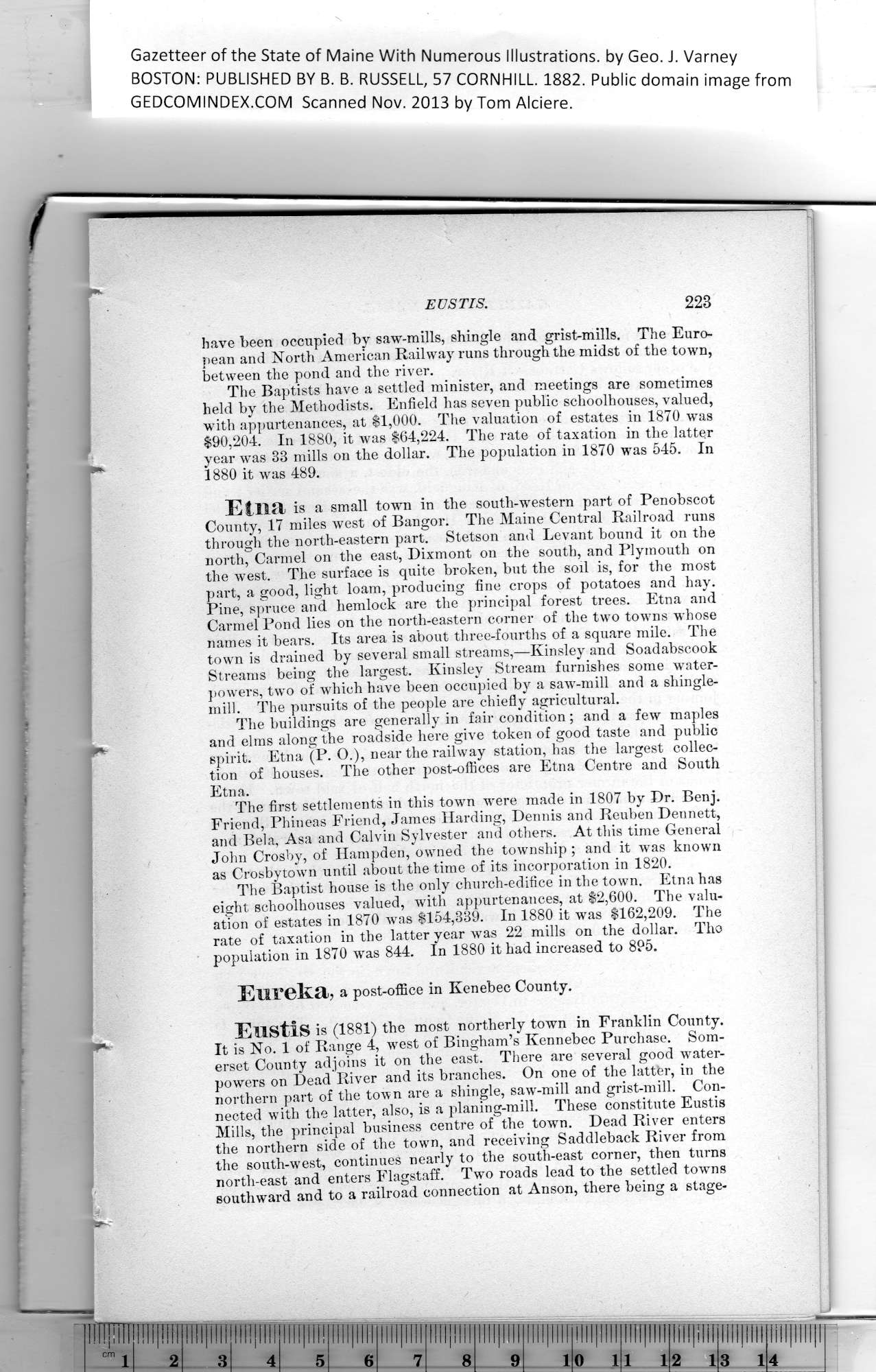|
EVSTIS.
have been occupied by saw-mills, shingle and grist-mills. The Euro-
pean and North American Railway runs through the midst of the town,
between the pond and the river.
The Baptists have a settled minister, and meetings are sometimes
held by the Methodists. Enfield has seven public schoolhouses, valued,
with appurtenances, at $1,000. The valuation of estates in 1870 was
$90,204. In 1880, it was $64,224. The rate of taxation in the latter
year was 33 mills on the dollar. The population in 1870 was 545. In
1880 it was 489.
Etna is a small town in the south-western part of Penobscot
County, 17 miles west of Bangor. The Maine Central Railroad runs
through the north-eastern part. Stetson and Levant bound it on the
north, Carmel on the east, Dixmont on the south, and Plymouth on
the west. The surface is quite broken, but the soil is, for the most
part, a good, light loam, producing fine crops of potatoes and hay.
Pine, spruce and hemlock are the principal forest trees. Etna and
Carmel Pond lies on the north-eastern corner of the two towns whose
names it bears. Its area is about three-fourths of a square mile. The
town is drained by several small streams,—Kinsley and Soadabscook
Streams being the largest. Kinsley Stream furnishes some water-
powers, two of which have been occupied by a sawr-mill and a shingle-
mill. The pursuits of the people are chiefly agricultural.
The buildings are generally in fair condition; and a few maples
and elms along the roadside here give token of good taste and public
spirit. Etna (P. O.), near the railway station, has the largest collec-
tion of houses. The other post-offices are Etna Centre and South
Etna.
The first settlements in this town were made in 1807 by Dr. Benj.
Friend, Phineas Friend, James Harding, Dennis and Reuben Dennett,
and Bela, Asa and Calvin Sylvester and others. At this time General
John Crosby, of Hampden, owned the township ; and it was known
as Crosbytown until about the time of its incorporation in 1820.
The Baptist house is the only church-edifice in the town. Etna has
eight schoolhouses valued, with appurtenances, at $2,600. The valu-
ation of estates in 1870 was $154,339. In 1880 it was $162,209. The
rate of taxation in the latter year was 22 mills on the dollar. Tho
population in 1870 was 844. In 1880 it had increased to 895.
Eureka, a post-office in Kenebec County.
EllStlS is (1881) the most northerly town in Franklin County.
It is No. 1 of Range 4, west of Bingham’s Kennebec Purchase. Som-
erset County adjoins it on the east. There are several good water-
powers on Dead River and its branches. On one of the latter, in the
northern part of the town are a shingle, saw-mill and grist-mill. Con-
nected with the latter, also, is a planing-mill. These constitute Eustis
Mills, the principal business centre of the town. Dead River enters
the northern side of the town, and receiving Saddleback River from
the south-west, continues nearly to the south-east corner, then turns
north-east and enters Flagstaff. Two roads lead to the settled towns
southward and to a railroad connection at Anson, there being a stage-
PREVIOUS PAGE ... NEXT PAGE
This page was written in HTML using a program written in Python 3.2
|
